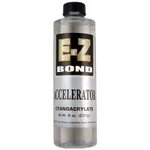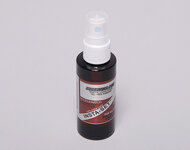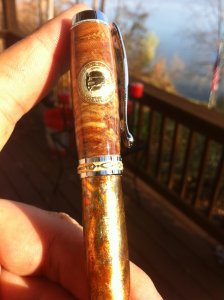soligen
Member
Getting back to some wood pens after a acrylic kick for a while, and I ran a little experiment.
I have noticed in the past that my glass like CA finishes would over time develop a little bit of texture. Still a gloss finish, but when looking at reflected light with my "Critical eye" I can see the texture. People in the automotive paint business call it "orange peal'
So, I turned 2 pens. I built up a nice thick CA finish, did just enough sanding to get rid of the shiny spots and took it off the lathe. As per my usual practice, it was a thick CA film with the CA probably .01 above the bushings (pleanty of room to size the pen using the finish). And I would guess .01 below the bushings too. (I probably should have noted measurements to be more scientific about it, but I decided this was an experiment after I started).
Pen one (a long click) sat in the shop for over a week
Pen 2 (a Le Roi) sat in the shop 2 days.
Both pens were made from wood & veneer that is been in my shop for years, last time I checked moisture of my shop stored wood it was 7%.
I completed each pen on the same day, (This was when I decided it was an experiment). I did the best CA finish I possible could - both looked outstanding with no texture or lines in reflected light (unmagnified).
Today (9.5 days later) I just examined both pens. Pen 1 looks just like I recall the day I completed it. Pen 2 has some of the texture to it that I can see without magnification, although to a lesser degree than pens where I applied CA and finished all in one day.
My conclusion is that the CA continues to cure for days after being applied. Even waiting 2 days and it still changed slightly on the pen.
I haven't exactly narrowed down how long it take the CA to fully cure, but I'm thinking for the best possible finish, wait a week. Thickness might affect cure time too.
Please don't take this wrong - you can get a great finish using CA without the wait - I'm just thinking this is for those pens you want to make extra special.
Has anyone else ever noticed anything similar?
This could partially be due to how thick I make my finishes. BTW, I use medium CA with accelerator.
I have noticed in the past that my glass like CA finishes would over time develop a little bit of texture. Still a gloss finish, but when looking at reflected light with my "Critical eye" I can see the texture. People in the automotive paint business call it "orange peal'
So, I turned 2 pens. I built up a nice thick CA finish, did just enough sanding to get rid of the shiny spots and took it off the lathe. As per my usual practice, it was a thick CA film with the CA probably .01 above the bushings (pleanty of room to size the pen using the finish). And I would guess .01 below the bushings too. (I probably should have noted measurements to be more scientific about it, but I decided this was an experiment after I started).
Pen one (a long click) sat in the shop for over a week
Pen 2 (a Le Roi) sat in the shop 2 days.
Both pens were made from wood & veneer that is been in my shop for years, last time I checked moisture of my shop stored wood it was 7%.
I completed each pen on the same day, (This was when I decided it was an experiment). I did the best CA finish I possible could - both looked outstanding with no texture or lines in reflected light (unmagnified).
Today (9.5 days later) I just examined both pens. Pen 1 looks just like I recall the day I completed it. Pen 2 has some of the texture to it that I can see without magnification, although to a lesser degree than pens where I applied CA and finished all in one day.
My conclusion is that the CA continues to cure for days after being applied. Even waiting 2 days and it still changed slightly on the pen.
I haven't exactly narrowed down how long it take the CA to fully cure, but I'm thinking for the best possible finish, wait a week. Thickness might affect cure time too.
Please don't take this wrong - you can get a great finish using CA without the wait - I'm just thinking this is for those pens you want to make extra special.
Has anyone else ever noticed anything similar?
This could partially be due to how thick I make my finishes. BTW, I use medium CA with accelerator.



